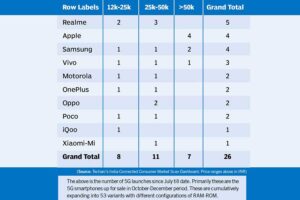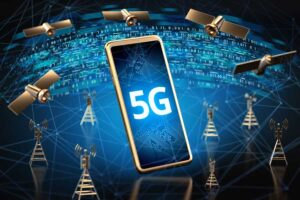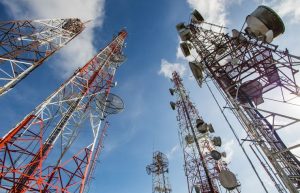The trend of purchasing a 5G smartphone is catching up in such a way that the consumers are willing to spend more to upgrade to a 5G-enabled device compared to a 4G model. Even brands are leaving no stone unturned in cashing in on this opportunity by offering “smartphones with 5G compatibility” as USPs, in order to entice consumers to think twice before purchasing a handset.
Deepak Wadhwa, a 22-year-old college graduate from Delhi University, recently purchased the Aurora colour variant of Oppo Reno 6 Pro 5G from an ecommerce platform. He is elated to have this new companion which he keeps showing off in his friend circle – it’s not because the smartphone has got a stunning design or it offers above par cameras or it ensures solid performance, but it’s a 5G-compatible device, which makes Reno 6 Pro future-proof. “There’s a lot of talk going on around the impending next-generation 5G telecom network and I’m happy to have Reno 6 Pro till the next few years instead of worrying about the device becoming obsolete,” says Wadhwa.
Likewise, 31-year-old marketing professional Shikha Bharti is planning to buy either an iPhone 12 series smartphone or the recently-launched iPhone 13 or a flagship 5G-enabled device from Samsung or OnePlus. Bharti says, “Since 5G is said to be the next big thing in the telecom space, it’s better to get a smartphone that is future-ready besides offering numerous other features that could be of great help to people like us.” She believes it’s smart to go for a 5G smartphone, keeping the future scenario in mind, which will ensure higher internet speed and lower latency.
There are millions of consumers like Deepak and Shikha who are consciously crazy about 5G smartphones and their much-talked-about benefits, even though India is yet to see the commercial roll out of the next generation technology which is said to dynamically reshape the telecom space. The trend is catching up in such a way that the consumers are willing to spend more to upgrade to a 5G smartphone compared to a 4G model. Interestingly, even brands are leaving no stone unturned in cashing in on this opportunity by offering “smartphones with 5G compatibility” as USPs, in order to entice consumers to think twice before purchasing a handset, which is quite natural.
Numbers say it all
If we talk about figures, India continued to see an upsurge in share of 5G smartphones as such devices accounted for 22 per cent of the market share in the third quarter of 2021, as per a recent report by CMR. Market share of 5G phones maintained a skyward trend with customers looking to future-proof themselves and companies prioritising 5G phones. CMR’s India Mobile Handset Market Review Report indicated that more than 20 5G-capable smartphones were launched over the course of Q3.
“Across price tiers, 5G smartphone shipments are gaining in strength, and contributing to increased affordability, availability and accessibility. With smartphone brands, such as OnePlus, Oppo, Realme, Samsung and Vivo prioritising 5G, and consumers seeking to future-proof themselves, 5G continues to gain momentum,” said Shipra Sinha, Analyst-Industry Intelligence Group, CMR. Sinha further said that together, these five brands shipped 5G smartphones in excess of $3 billion during the September 2021 quarter. Vivo led the 5G smartphone segment with an 18 per cent market share, followed by Samsung at 16 per cent, according to CMR.
For the entire year, CMR estimates point to a potential 5-8 per cent year-on-year growth in smartphone shipments. In the fourth quarter, CMR anticipates the ongoing supply constraints, high components and logistics costs, and consequent high retail costs, to continue challenging smartphone brands. On the demand side, aided by the availability of attractive affordability schemes, smartphone upgraders are seeking better-specced 5G-capable phones.
In the recent festive season sales, the strong consumer demand for smartphone upgrades has been met by aggressive offers in the value for money and premium smartphone segments from smartphone brands, as per CMR. Remarkably, more than 84 per cent of mid-range segment of smartphones bought on popular ecommerce platform Amazon were 5G-ready. Over one million customers purchased a smartphone on Amazon for the first time during its month-long Great Indian Festival 2021. Earlier, in a survey, Amazon had said more than 54 per cent of respondents were looking for a 5G-compatible phone.
“In Q4 2021 and beyond, the supply chain constraints will continue to persist. Smartphone brands that are able to augment their component supplies, and plan in advance their market outreach strategies, will be able to succeed. CyberMedia Research (CMR) anticipates consumer sentiment to remain robust during this period, driven by India’s growing digital transformation,” said Anand Priya Singh, Analyst-Industry Intelligence Group, CMR.
Market forecast
Research firm IDC said that India was the third-largest 5G smartphone market globally with 7 per cent of worldwide 5G shipments, shipping 10 million units at an Average Selling Price (ASP) of $401 (approx. Rs 29,853) in 3Q21. From January-September’21, 17 million 5G smartphones were shipped to India and are expected to be under 30 million for 2021. The OnePlus Nord CE, iPhone 12 and Samsung Galaxy A22 were the most popular 5G models in 3Q21, as per IDC’s Worldwide Quarterly Mobile Phone Tracker. Interestingly, it said the sub-$200 segments dropped by 24 per cent, while $200+ smartphones grew by 56 per cent, signalling a shift to higher price buckets, driven primarily by supply.
Meanwhile, Counterpoint Research forecasts that India’s 5G smartphone installed base will cross 35 million by the end of 2021 from over 17 million in August. According to reports quoting Prachir Singh, Senior Research Analyst at Counterpoint, the 5G smartphone sales will cross 50% by value of the total smartphone market in 2021 festive season and 30% by volume.
According to Techarc, 5G smartphone sales for the calendar year 2021 is estimated to be 28.3 million units, out of which 12.7 million are expected to be sold during the festive quarter of fourth quarter alone. Faisal Kawoosa, Founder and Chief Analyst at Techarc, said, “5G is definitely going to be a preferred specification for the October-December quarter sales of smartphones as people are buying expensive smartphones of higher ASPs. So, they will want their investment to be future proof. At the same time, the industry has also complemented very well in terms of making 5G smartphones available across price points. So, in whatever price range a user is looking to buy a smartphone, can explore buying a 5G smartphone.”
Key drivers
India is a “devices go first” market for 5G, with first handset made available back in February 2020 by Realme. Since then, market has witnessed plethora of devices in spite of no spectrum available. So, what are the factors driving people to upgrade their smartphones to 5G in India? Competitive pricing with 4G variants is the major factor driving the popularity of 5G phones. Brands like Oppo, Realme and Xiaomi have already launched affordable 5G smartphones at Rs 15k price points, while the likes of Vivo, OnePlus and Apple have 5G offerings in the mid-premium and premium range above Rs 30k.
As per CMR, 5G-readiness is one of the top three consumer considerations, alongside battery life and smartphone brand imagery. “In India 5G is a sort of luxury feature which consumers are choosing to be future-proof,” said reports quoting an analyst, who did not wish to be named. Brands like Oppo and Realme, he said, are using 5G as an attractive selling proposition and making it affordable for Indian consumers by launching phones priced below Rs 15k.
“IDC expects a boost in 5G shipments with more affordable devices – lowering the ASP gap between 4G Vs 5G devices, without compromising on key specifications, stickiness through financing/trade-in programs and better discounts/offers. Further IDC expects US$250+ price segment to be 5G dominated by end 2021,” said Upasana Joshi, Research Manager, Client Devices, IDC India.
Faisal Kawoosa of Techarc said, “The biggest enabler for 5G uptake has been the chipset enablement in the mid-range which allowed OEMs to launch 5G smartphones in affordable segment. This has substantially increased 5G smartphone sales in India even when there is no service available. By 2022, we estimate that 1/3rd of smartphones sold in India will be 5G and close to 10% of the user base will be 5G enabled.”
According to Techarc, since July 2021, 26 smartphones launched were 5G-enabled. “These smartphones are cumulatively expanding into 53 variants with different configurations of RAM-ROM. Primarily these are the 5G smartphones up for sale in Q4,” said Kawoosa.
Millennials – The trend setter
Amid all these facts and figures, there’s a very interesting development! The awareness and willingness to buy a 5G smartphone is highest among millennials or people aged between 21 to 30 years old when it comes to 5G interest among consumers. According to a recent study by market analytics firm PredictiVu, 73% of surveyed smartphone owners are interested in buying a 5G smartphone while nearly 25% (or 1 in 4) MBO consumers are 5G aware.
PredictiVu’s findings stressed that 5G is going to be a major driver for consumers to upgrade their smartphones and Muti Brand Outlets (MBOs) need to have better 5G advertisements and have an effective omnichannel marketing strategy in place to attract more women buyers, a high potential market segment, to their offline stores. Currently, 94.3% of consumers are buying from local retail stores while only 4.7% of consumers shopped from MBO chains. MBOs though have a high potential to educate consumers in-store on 5G technology-enabled smartphones.
“The 5G adoption is going to be a big driver for consumers to upgrade their smartphones and so offline retail MBOs are gearing to deliver convenient and personalized experiences to the consumers. By leveraging robust consumer base, local consumer relationships and social media, offline smartphone retailers can influence the consumers decision making process. Raising consumer awareness is imperative now,” said Kunal Sarkar, Vice President, PredictiVu.
“Offerings and strategies to woo consumers to shift purchase focus to offline stores is important. Therefore, it is imperative that retailers play a key role in educating consumers on 5G enabled smartphones. Better partnerships with brands, monitoring online exchange schemes to offer better deals, attractive advertisements using omni-channel and hyperlocal marketing strategy are some of the factors that can help in improving foot traffic to physical locations of the MBOs,” added Sarkar.
Online or offline – Which is going to win?
This year, of course, it was online channels which gained the maximum traction, found Techarc. “Next year onwards, the opportunity should divide equally for offline and online channels,” hopes Kawoosa.
As per PredictiVu, in Q3, online as well as offline performed at par in small towns and cities, online smartphone sales saw record sales in beginning of October due to festival offers and big sales run by the leading online players. “Eventually by the year end, we can expect the online-offline market share to be 55:45. The outlook for Q4 looks positive, an increase in festival-related discount offers from online players coupled with a growing shortage of semiconductors might hamper the growth prospects for MBOs. The offline smartphone MBOs are going all out to woo consumers with innovative, marketing strategies to win in the new normal,” said Sarkar.
If the PredictiVu survey is to be believed, India’s top 5 metros leaned towards online channels and top 50 Indian cities accounted for 60% of smartphone sales, MBOs claimed 45% of the total sales. The offline retail emerged as the biggest sales channel in India contributing more than half of all smartphone sales despite the unprecedented pandemic-triggered online boom.
“Realizing the strong buying potential (73%) for 5G-enabled smartphones among the consumers in tier 2 and 3 cities, marketers need to create awareness, hire female staff and look for the right blend of technology, innovation, in-store promotions and deals to influence purchase decision of the audience,” advises Sarkar.
Remarkable development but network a far cry
Given that the global smartphone ecosystem is moving towards the fifth generation of cellular networks, the manufacturers are able to leverage favourable 5G supply chain dynamics and introduce 5G-ready handsets across all price segments in India. Consequently, the OEMs are paving the way for a 5G devices-ready market even before the 5G network implementation in India. It must be noted that while 4G required four years to reach annual shipment numbers exceeding 200 million units, 5G has hit the mark much faster after just two, which is very remarkable, especially considering the severe difficulties faced by the world in 2020 and the year after i.e. 2021.
But how sensible is it from the consumer’s perspective to buy a 5G device, especially when the network implementation looks a far cry? Just think! Upasana Joshi of IDC India has this to say, “We are still far away from 5G becoming mainstream for another year or so, underlining the importance of spectrum availability, clear use cases and a cohesive future-ready infrastructure led by telcos.”
Consumers speak:
“I would prefer iPhone 12 to experience 5G”
Keeping the future scenario in mind, 5G smartphone is surely the thing I would like to bet on. Speed matters, especially in the post-pandemic world. Smartphones are more than just “phones,” it has become our theatre, gaming battlegrounds, a platform to keep track of IoT devices, and many more. The dual benefit — higher download speed and lower latency — will be the driving force behind my intent to have a 5G smartphone. I would prefer iPhone 12 that can provide me with privacy and data security as an additional benefit.
– Kumar Gaurav, a PR professional
“5G is the future of smartphones”
I really want to get hold of one of the 5G providers anytime soon, after all, that’s the future of smartphones. Now that we are living in a world where work from home and online classes are becoming a way of life, the power of innovation can only enhance our experience to do better. Whether it is for work, news feeds, gaming or binge-watching, we want to stay constantly engaged and rely on our smartphones. It’s actually not limited to that only. Smartphones have enabled many small businesses to operate remotely, thanks to faster network services. The smartphone market will boom with 5G, and everyone can benefit from it.
– Sriparna Choudhury, a communication manager
“Using a 5G phone will help me work more efficiently”
I bought Vivo V21 5G smartphone, as the future is 5G and it will be a prime requirement if the next generation network is rolled out in India. Using a 5G phone will help me work more efficiently because I operate multiple apps on my phone at a time and a 5G phone provides higher speed, lower latency and greater capacity. By the way, the world is growing at a fast pace and the advancement of technology is one of its factors. Buying a 5G smartphone is required, as it’ll make your life easier. Also, nobody wants to use old technology phones these days.
– Lakshender S Angras, a publicist
“I wanted to be future proof with OnePlus 8T 5G”
I bought OnePlus 8T, it was one of the first devices to be launched with 5G bands in India. I wanted to be future proof with my device. If any operator launches 5G in the country today, I’ll be ready to kick-start my journey with its high speed cellular connectivity. I’m glad even during the turbulent 2020, 5G was rolling out at a good pace all over the earth. We are living in an environment where using a high-speed 5G phone will make life easier. Buying a 5G smartphone becomes more important now, as speed will matter a lot with the roll out of 5G network in India.
– Kratika Chhabra, an influencer manager
Wait for 5G in India gets longer as telcos granted more time for trials
In a major relief to the telecom operators, the Department of Telecommunications (DoT) has extended the validity of the 5G trial permit to Reliance Jio, Vodafone Idea and Bharti Airtel by six months, allowing them to conduct 5G experiments until May 2022. “DoT gave an extension for 5G trials for a period of six months. We received a letter from the DoT earlier this week,” said a report quoting a telecom official.
License for undertaking trials expires on November 26, but industry analysts argued that the 5G ecology needs extra time to test out different services. Six months ago, the DoT allotted 5G trial spectrum to operators in the 3.5 GHz, 26 GHz and 700 MHz bands. Telcos are using this spectrum to create and test a range of India-specific use cases, either on their own or via strategic alliances and joint ventures.
At the moment, the DoT is also engaging with the Telecom Regulatory Authority of India to get base pricing suggestions. However, telcos would need to pay Rs 50,000 crore to purchase 100 MHz of 5G spectrum in the 3.3-3.6 GHz band, which is required on average to implement 5G technology, as per the current reserve price which is too expensive according to telcos for them to buy.
This extension of testing is expected to delay India’s commercial 5G deployment, as it would postpone the much-anticipated spectrum auction process which was expected to take place between January and March. The DoT has begun the process of commercialising 5G by requesting feedback from telecom regulator TRAI on spectrum auction pricing and procedure. While there is no clarity on the auction’s scheduling, industry insiders anticipate it will take place between April and June 2022.













